Technology-Enabled Learning for Green and Sustainable Entrepreneurship Education
Abstract
1. Introduction
1.1. Background and Objectives of the Study
1.2. Research Gap and Novelty
- Developing a cloud-based educational system that integrates three e-learning platforms tailored for sustainable entrepreneurship education.
- Providing practical insights through field research, including interviews with entrepreneurs engaged in green practices, and creating a data repository of real-world case studies to support experiential learning.
- Developing a methodology for creating digital content using raw data on green businesses gathered from real-world sources, converted into a structured computational format with the help of advanced IT technologies as generative AI.
- Incorporating innovative learning technologies, including conceptual learning frameworks, to deepen students’ understanding of green business principles.
- Exploring the use of AI-driven recommendation systems to provide personalized guidance in designing sustainable business models.
2. Brief Review of the State of the Art in Entrepreneurial Education and Technology-Enabled Learning
2.1. Literature Review Insights for Technology-Enabled Entrepreneurship Education
2.2. Background Research in the Educational Context
2.3. Instructional Theories Research for Technology-Enabled Green Entrepreneurship Education
2.4. Conceptual Learning Theory and Entrepreneurship Education
- Understanding over memorization: Emphasizes deep comprehension of core concepts instead of rote memorization. Learners focus on the “why” and “how” behind knowledge to build meaningful connections.
- Knowledge organization: Concepts are organized into schemas or frameworks that help learners relate the new information to prior knowledge. Encourages categorization and pattern recognition.
- Transfer of learning: Promotes the ability to apply learned concepts to new situations or problems, enhancing adaptability. Focuses on generalization across contexts rather than context-specific skills.
- Active engagement: Learners actively construct knowledge through questioning, discussion, and exploration. Encourages inquiry-based learning methods.
- Concept mapping: visual tools such as concept maps help illustrate relationships between concepts, aiding comprehension, and retention.
- Contextualized learning: concepts are taught within relevant and meaningful contexts to enhance understanding and applicability.
2.5. Use of Knowledge Graphs for Conceptual Learning
2.6. Generative AI Chatbots and GraphRAG
3. Methods
3.1. Development the of Learning Content for Green Entrepreneurship Education
- Conducting research to identify various aspects of business practices related to green and sustainable entrepreneurship and exploring opportunities to incorporate these findings into EE experiences through digital learning.
- Creating digital learning content on green, sustainable, and innovative entrepreneurship and choosing suitable methods to deliver this content to students.
- Identifying the educational settings to deliver the new courses for green and sustainable entrepreneurship education.
- Collecting user feedback after a pilot test, and improving the GSB platform’s features based on the evaluations from learners and educators.
- Literature review: A literature review was conducted to gain insights into technology-enabled entrepreneurship education (EE), the impact of instructional theories for green EE, and the educational context, as outlined in Section 2. Additionally, a review of literature on green and sustainable entrepreneurship, including scholarly articles (Hockerts, 2017; Linnenluecke & Griffiths, 2010; Zhang et al., 2020) and recent online reports (Eurostat, 2023; EC, 2019, 2022) was undertaken.
- Field research: Field research was conducted through semi-structured interviews with key stakeholders, including entrepreneurs and industry experts. This research aimed to examine and gather information on eco-friendly practices and strategies adopted by businesses in various European countries.
- Methodology development: a methodology was developed to create learning content from the raw data on green business practices gathered through field research.
- Creation of digital content: based on the methodology developed in the previous phase, the raw data collected during the field research were converted into a structured digital format using advanced IT technologies, including generative AI.
- Refining the educational content created in the previous phases according to the feedback received from users in order to ensure that the intended knowledge is effectively acquired upon completing the training.
3.2. Research Methodology for Creating Digital Learning Content
- Data collection through field research.
- Data analysis for creating a repository of case studies on green and sustainable business solutions.
- Data conversion into digital content for conceptual learning purposes.
- Data categorization for knowledge graphs creation.
3.2.1. Data Collection Through Field Research
3.2.2. Data Analysis for Creating a Repository of Case Studies on Green and Sustainable Business Solutions
3.2.3. Data Conversion into Digital Content for Conceptual Learning
- Information extraction,
- data validation, and
- data organization.
3.2.4. Data Categorization for Ontologies and Knowledge Graphs Creation
4. Results
4.1. A Cloud System for Entrepreneurship Education
- The business modeling (BM) e-learning platform, which teaches entrepreneurship through business modeling and financial evaluation of entrepreneurial projects,
- the business innovation and networking (BIN) e-learning platform, which offers interactive lessons on several types of entrepreneurships and supports professional networking in this field, and
- the green and sustainable business (GSB) e-learning platform, which focuses on learning, planning, and modeling of green and sustainable businesses.
- Key partners: identifies collaborating partners, stakeholders, or organizations and outlines their motivations for participating in the business venture.
- Key activities and key resources: specifies the core activities (e.g., production, commerce, and problem solving) and the necessary resources (e.g., physical, intellectual, and financial) to conduct these activities.
- Value proposition and customer segments: represents the value the business aims to deliver (e.g., innovation, cost reduction) and identifies the target beneficiaries.
- Customer relationships and channels: describes the nature of interactions with beneficiaries (e.g., personal assistance, community, and co-creation) and the means (e.g., distribution, communication) through which the value created will be delivered.
- Cost structure and revenue streams: details the major costs involved in the business and the methods of generating income.
4.2. The Green Business Innovation Canvas
4.3. Ontologies for Learning and Teaching Green and Sustainable Entrepreneurship
- T is the trigger class and TPs are its primary subclasses: environmental, social, and financial triggers.
- TPS refers to the subclasses for each of the primary trigger categories.
- BMC is the business model canvas class, with the BMC-B subclasses corresponding to the nine blocks of the business model canvas.
- BMC-BS refers to subclasses for each of the nine BMC blocks.
- R represents the relationship between the classes of concepts and their subclasses.
- GBTrig-O represents the classes and class-subclass relationships within the ontology.
- I refers to instances of concepts or entities within the ontological classes.
- A denotes the attributes of entities, including relationships labeled as DescriptionOf, which connect entities/instances to specific values or properties.
- P represents the properties of entities, expressed as textual or numerical values.
- V is the set of nodes representing entities (knowledge points).
- E ⊆ V × V is the set of edges representing relationships.
- {xv} ∀ v ∈ V and {xe} ∀ e ∈ E represent the sets of textual attributes (e.g., labels or names) associated with nodes and edges.
- An unstructured document chunking phase,
- a concepts and relationships extraction phase,
- the construction of knowledge graphs, and
- the storage of the knowledge graphs into the AI chatbot’s vector database.
4.4. Digital Materials for Learning and Teaching Green and Sustainable Entrepreneurship
- Reading materials in various formats and online assessment exercises to build understanding of green and sustainable entrepreneurship concepts and their application in business contexts.
- Practical exercises to foster creativity in business creation and development.
- Gamification elements rewarding the completion of puzzle exercises, designed to enhance retention of key concepts in the field.
- Good practice guides for business modeling, along with case studies and scenarios demonstrating solutions for integrating sustainability and innovation into business projects.
- An interactive green business innovation canvas (GBIC) to help users incorporate sustainability triggers and innovation into their business models.
- Green business innovation matrices (GBIMs) inspired by the theory of inventive problem solving—TRIZ, (TRIZ Innovation Center, 2024), problem-solving schemes, to assist users in identifying green practices for their businesses (Savransky, 2000).
- The Protégé system as a conceptual learning assistant, allowing users to explore and query GBTrig and GBTeach ontologies interactively.
- The Green Business Recommendation system, a generative AI chatbot enhanced with a GraphRAG pipeline, providing answers to questions on implementing sustainability in business projects.
4.5. Last Phases in Development of Digital Content Education in Green and Sustainable Entrepreneurship
- Collecting feedback from educators, stakeholders, and entrepreneurs.
- Collecting feedback from students.
- Enhancing the platform’s features and services based on user feedback.
5. Discussion
5.1. Analysis of the Results from the Perspective of the Research Questions
5.2. Contingencies with Other Aspects of the Socio-Economic Development
5.3. Comparison of Current Study with Related Research
- “Green Technology in Education: Key to Sustainable Development” (Sadh, 2019) is an article discussing the role of green technology in education and its importance for sustainable development. It emphasizes the integration of green elements into educational programs to promote sustainability. While research work emphasizes sustainability, the current study focuses specifically on integrating technology-enabled learning into entrepreneurship education, with a detailed methodology for developing digital tools and pedagogical approaches.
- “Technology-Enhanced Learning and Education for Sustainable Development” (Polanco O’Neil, 2019) is an article exploring the intersection of technology-enhanced learning (TEL) and education for sustainable development (ESD). It discusses the challenges and innovations of using technology to support sustainable education. Both papers address the use of technology in sustainable education. However, our article goes further by detailing the development of a cloud-based system and specific e-learning platforms for green entrepreneurship, including the use of knowledge graphs and generative AI.
- “The Impact of E-Learning Technologies on Entrepreneurial and Sustainable Development” (Liu et al., 2023) is an article examining how e-learning technologies can be applied to entrepreneurship education, highlighting the benefits and challenges of integrating these technologies. The current article offers a more comprehensive approach, discussing the integration of e-learning technologies and also presenting a structured methodology for creating digital content and tools specifically for green and sustainable entrepreneurship.
5.4. Limitations
- Focus on specific technologies: The research concentrated on the use of conceptual learning tools and generative AI. While these technologies demonstrate considerable potential, other emerging tools and pedagogical innovations were not explored. Integrating additional technologies, such as augmented reality, could enhance the scope and applicability of the proposed educational frameworks.
- Short-term evaluation: The effectiveness of the e-learning platforms and tools was assessed primarily through pilot studies and short-term feedback from learners and educators. Longitudinal studies are necessary to evaluate the sustained impact of these tools on learners’ knowledge retention and entrepreneurial skills development.
- Sample size and diversity: The empirical research involved a limited number of entrepreneurs and educators from European countries. Although the findings revealed significant aspects of green business practices, the results may not fully represent the perspectives of entrepreneurs from other regions or socio-economic contexts.
- Nonetheless, the model developed from this research, utilizing trigger-based case studies, good practice guides, and creativity-supporting learning tools, led to the creation of original educational content and pedagogy.
6. Concluding Remarks
6.1. Study Results and Benefits
- Development of a cloud-based system: the article introduces a cloud-based system for entrepreneurship education (CSEE) that includes three e-learning platforms tailored for sustainable entrepreneurship education.
- Developing a methodology for creating digital content: the study presents a step-by-step method to develop digital learning content using data on green businesses gathered from real-world sources, then analyzed and converted them into a structured computational format with the help of advanced IT technologies, such as the generative AI.
- Integration of knowledge graphs: The use of knowledge graphs (KGs) to support conceptual learning is a significant contribution. KGs help organize and represent knowledge in a structured format, facilitating data integration and retrieval. This approach enhances students’ understanding of complex concepts and relationships in green entrepreneurship.
- Generative AI and GraphRAG: The article discusses the integration of generative AI chatbots and graph retrieval-sugmented generation (GraphRAG) frameworks. These technologies improve the quality and relevance of AI-generated content by incorporating relational knowledge from pre-constructed graph-based data structures.
- Green business innovation canvas (GBIC): The introduction of the GBIC as a digital framework for designing eco-friendly business projects is another original contribution. This tool helps users balance environmental objectives with profitability, promoting sustainable business practices.
- Ontologies for learning and teaching: The development of the green business triggers ontology (GBTrig-O) and the corresponding knowledge graph (GBTrig-KG) provides a structured framework for integrating green business practices into entrepreneurship education. This ontology supports the creation of educational content that reflects real-world knowledge interrelations.
- Practical implications for educators: the digital tools and pedagogical methods developed in this research provide a scalable model for embedding sustainability into entrepreneurship curricula.
- Practical relevance for users: the concise, easy-to-understand instructional content provided by the conceptual learning tools can accelerate comprehension of principles and processes, fostering goal-oriented and innovation-driven learning.
- Future applications: the study’s integration of advanced digital technologies sets a precedent for future innovation in EE, especially in the context of sustainability.
6.2. Future Trends and Emerging Issues in Technology-Enabled Learning for Entrepreneurship
- Advancements in educational technologies: The integration of AI, virtual reality (VR), and augmented reality (AR) into education is likely to reshape how learners interact with content. These technologies could reduce the digital divide by providing immersive learning experiences, even in resource-constrained settings. However, their implementation requires significant investment and training for educators.
- Increased focus on lifelong learning: As industries continue to evolve, there will be a growing demand for lifelong learning programs to help individuals upskill and reskill. E-learning platforms tailored for sustainable entrepreneurship could play a key role in bridging the skills gap, especially in marginalized communities.
- Decentralized and open education: Blockchain and decentralized platforms might enable more equitable access to learning by allowing learners to document achievements securely and access open educational resources. This trend could mitigate the digital divide by democratizing education.
- Accessibility and infrastructure challenges: The digital divide remains a critical barrier in many regions where access to technology and reliable internet is limited. Addressing this issue will require collaborative efforts between governments, private sectors, and educational institutions to ensure equitable access.
- Digital literacy gaps: Even with access to technology, a lack of digital literacy can hinder participation in online education. Efforts to build digital skills among learners and educators must accompany the deployment of advanced technologies.
- Economic disparities and equity: While digital tools can reduce some inequities, they may also exacerbate others if technological advancements disproportionately benefit privileged groups. Future strategies should focus on designing inclusive systems that cater to diverse socio-economic backgrounds.
- Data privacy and ethical concerns: The increasing use of AI and data-driven systems in education raises concerns about data privacy and algorithmic biases. Future developments must prioritize ethical frameworks and transparency in technology use.
Author Contributions
Funding
Institutional Review Board Statement
Informed Consent Statement
Data Availability Statement
Conflicts of Interest
References
- Abu-Salih, B., & Alotaibi, S. (2024). A systematic literature review of knowledge graph construction and application in education. Heliyon, 10(3), e25383. [Google Scholar] [CrossRef] [PubMed]
- Ansar, M., Namreen Asif, V. A., & Mahale, P. (2024). Green entrepreneurship education: Fostering sustainable innovation in business management programs. International Research Journal of Modernization in Engineering Technology and Science, 6(2), 822–829. [Google Scholar] [CrossRef]
- Bell, R., & Bell, H. (2023). Entrepreneurship education in the era of generative artificial intelligence. Entrepreneurship Education, 6, 229–244. [Google Scholar] [CrossRef]
- Bogoslo, I. A., Lungu, A. E., Stoica, E. A., & Georgescu, M. R. (2022). European green deal impact on entrepreneurship and competition: A free market approach. Sustainability, 14(19), 12335. [Google Scholar] [CrossRef]
- Brandes, U., Eiglsperger, M., Lerner, J., & Pich, C. (2014). Graph markup language (GraphML). In R. Tamassia (Ed.), Handbook of graph drawing and visualization (pp. 517–541). CRC Press. Available online: https://cs.brown.edu/people/rtamassi/gdhandbook/chapters/graphml.pdf (accessed on 29 November 2024).
- Brentnall, C., & Higgins, D. (2024). Entrepreneurship educators in an age of climate and ecological breakdown. Entrepreneurship Education and Pedagogy, 25151274241277828. [Google Scholar] [CrossRef]
- Buchem, I., & Hamelmann, H. (2010). Microlearning: A strategy for ongoing professional development. eLearning Papers, 21, 1–15. Available online: https://www.researchgate.net/profile/Ilona-Buchem/publication/341323117_Microlearning_a_strategy_for_ongoing_professional_development/links/5ebabd26a6fdcc90d66ebfbc/Microlearning-a-strategy-for-ongoing-professional-development.pdf (accessed on 29 November 2024).
- Debellis, M. (2021). A practical guide to building OWL ontologies using Protégé 5.5 and plugins. Available online: https://www.researchgate.net/publication/351037551_A_Practical_Guide_to_Building_OWL_Ontologies_Using_Protege_55_and_Plugins (accessed on 29 November 2024).
- Edge, D., Trinh, H., Cheng, N., Bradley, J., Chao, A., Mody, A., Tritt, S., & Larson, J. (2024). From local to global: A Graph RAG approach to query-focused summarization. Available online: https://arxiv.org/abs/2404.16130 (accessed on 29 November 2024).
- Education Audiovisual and Culture Executive Agency Eurydice. (2016). Entrepreneurship education at school in Europe: Eurydice report. Publications Office. Available online: https://data.europa.eu/doi/10.2797/301610 (accessed on 29 November 2024). [CrossRef]
- EntrNET Project. (2023). Develop national networks of adult education providers in the field of entrepreneurship. Available online: https://entrnet.eu (accessed on 29 November 2024).
- European Commission. (2019). The European green deal. Available online: https://eur-lex.europa.eu/legal-content/EN/TXT/?uri=CELEX%3A52019DC0640 (accessed on 29 November 2024).
- European Commission. (2022). Circular economy action plan. Available online: https://environment.ec.europa.eu/strategy (accessed on 29 November 2024).
- Eurostat. (2023). Circular economy: Monitoring framework. Available online: https://ec.europa.eu/eurostat/web/circular-economy/monitoring-framework (accessed on 29 November 2024).
- Ferrati, P., Kim, A., & Moffato, M. (2024). Generative AI in entrepreneurship research: Principles and practical guidance for intelligence augmentation. Foundation and Trends in Entrepreneurship, 20(3), 245–383. [Google Scholar] [CrossRef]
- Freudenreich, B., Lüdeke-Freund, F., & Schaltegger, S. (2019). A stakeholder theory perspective on business models: Value creation for sustainability. Journal of Business Ethics, 166(1), 3–18. [Google Scholar] [CrossRef]
- Galindo, M., & Méndez, M. T. (2014). Entrepreneurship, economic growth, and innovation: Are feedback effects at work? Journal of Business Research, 67(5), 825–829. [Google Scholar] [CrossRef]
- Gao, Y., Xiong, Y., Gao, X., Jia, K., Pan, J., Bi, Y., Dai, Y., Sun, J., Wang, M., & Wang, H. (2024). RAG for large language models: A survey. arXiv, arXiv:2312.10997. [Google Scholar]
- Ghimire, A., Prather, J., & Edwards, J. (2024). Generative AI in education: A study of educators’ awareness, sentiments, and influencing factors. arXiv, arXiv:2403.15586. [Google Scholar]
- Giacomin, O., Janssen, F., Pruett, M., Shinnar, R. S., Llopis, F., & Toney, B. (2011). Entrepreneurial intentions, motivations and barriers: Differences among American, Asian and European students. International Entrepreneurship and Management Journal, 7(2), 219–238. Available online: https://www.researchgate.net/publication/226846217_Entrepreneurial_Intentions_Motivations_and_Barriers_Differences_Among_American_Asian_and_European_Students (accessed on 29 November 2024). [CrossRef]
- Graevenitz, G., Harhoff, D., & Weber, R. (2010). The effects of entrepreneurship education. Journal of Economic Behavior & Organization, 76(1), 90–112. Available online: https://www.sciencedirect.com/science/article/pii/S0167268110001216 (accessed on 29 November 2024).
- Hockerts, K. (2017). Sustainable entrepreneurship. In A research agenda for entrepreneurship and context. Edward Elgar Publishing. [Google Scholar]
- Hu, Y., & Lu, Y. (2024). RAG and RAU: A survey on retrieval-augmented language model in natural language processing. arXiv, arXiv:2404.19543. [Google Scholar]
- InnoGreen Project. (2024). Innovative entrepreneurs leading green businesses. Available online: https://innogreen.ugal.ro/site/ (accessed on 29 November 2024).
- Katz, J. A. (2003). The chronology and intellectual trajectory of American entrepreneurship education: 1876–1999. Journal of Business Venturing, 18(3), 283–300. Available online: https://www.sciencedirect.com/science/article/abs/pii/S0883902602000988 (accessed on 29 November 2024). [CrossRef]
- Kozlinska, I. (2011). Contemporary approaches to entrepreneurship education. Business Management Journal, 4, 205–220. [Google Scholar]
- Lackéus, M. (2015). Entrepreneurship in education: What, why, when, how? OECD local economic and employment development papers. OECD Publishing. Available online: https://www.oecd.org/en/publications/entrepreneurship-in-education_cccac96a-en.html (accessed on 29 November 2024).
- Li, T., Huang, H., Mao, M., Lan, S., Lin, Z., Li, Y., Huang, Z., Zhou, Y., & Zheng, Z. (2024, October 30–31). Research on comprehensive software engineering practical training course based on constructivism learning theory. 2024 7th International Conference on Economics, Management Engineering and Education Technology (ICMEET), Sydney, Australia. Available online: https://webofproceedings.org/proceedings_series/ECOM/ICEMEET%202024/ET12.pdf (accessed on 29 November 2024).
- Li, Z., Cheng, L., Zhang, C., Zhu, X., & Zao, H. (2023, July 10–13). Multi-source education knowledge graph construction and fusion for college curricula. 2023 IEEE International Conference on Advanced Learning Technologies (ICALT), Orem, UT, USA. Available online: https://arxiv.org/abs/2305.04567 (accessed on 29 November 2024).
- Lin, J., & Sekiguchi, T. (2020, December 8–11). E-learning in entrepreneurship education: A systematic literature review. IEEE International Conference on Teaching, Assessment, and Learning for Engineering (TALE 2020), Takamatsu, Japan. [Google Scholar]
- Linnenluecke, M. K., & Griffiths, A. (2010). Corporate sustainability and organizational culture. Journal of World Business, 45(4), 357–366. Available online: https://www.sciencedirect.com/science/article/pii/S1090951609000431 (accessed on 29 November 2024). [CrossRef]
- Liu, S., Sun, H., Zhuamg, J., & Xiong, R. (2023). The impact of e-learning technologies on entrepreneurial and sustainability performance. Sustainability, 15(21), 15660. Available online: https://www.mdpi.com/2071-1050/15/21/15660 (accessed on 29 November 2024). [CrossRef]
- Lythreatis, S., Singh, S. K., & El-Kassar, A. N. (2022). The digital divide: A review and future research agenda. Technological Forecasting and Social Change, 175, 121359. Available online: https://www.sciencedirect.com/science/article/pii/S0040162521007903 (accessed on 29 November 2024).
- McLellan, E. (2005). Conceptual learning: The priority for higher education. British Journal for Educational Studies, 53(2), 129–147. Available online: https://www.researchgate.net/publication/227837374_Conceptual_Learning_The_Priority_for_Higher_Education (accessed on 29 November 2024). [CrossRef]
- McLeod, S. (2024). Kolb’s learning styles and experiential learning cycle. Available online: https://www.simplypsychology.org/learning-kolb.html (accessed on 29 November 2024).
- Morselli, D. (2018). Teaching a sense of initiative and entrepreneurship with constructive alignment in tertiary non-business contexts. Education & Training Journal, 60(2), 122–138. Available online: https://www.emerald.com/insight/content/doi/10.1108/et-06-2017-0093/full/pdf?title=teaching-a-sense-of-initiative-and-entrepreneurship-with-constructive-alignment-in-tertiary-non-business-contexts (accessed on 29 November 2024).
- Naggar, R. (2015). The creativity canvas: A business model for knowledge and idea management. Technology Innovation Management Review, 5(7), 50–58. Available online: https://www.researchgate.net/publication/326307584_The_Creativity_Canvas_A_Business_Model_for_Knowledge_and_Idea_Management (accessed on 29 November 2024). [CrossRef]
- Neck, H. M., & Greene, P. G. (2011). Entrepreneurship education: Known worlds and new frontiers. Journal of Small Business Management, 49(1), 55–70. Available online: https://www.researchgate.net/publication/228270128_Entrepreneurship_Education_Known_Worlds_and_New_Frontiers (accessed on 29 November 2024). [CrossRef]
- Novak, J. D. (2010). Learning, creating, and using knowledge: Concept maps as facilitative tools in schools and corporations. Routledge. [Google Scholar]
- OECD. (2024). Digital economy outlook. Available online: https://www.oecd.org/en/publications/oecd-digital-economy-outlook-2024-volume-2_3adf705b-en.html (accessed on 29 November 2024).
- Omer, A. (2020). What is micro-learning and what are the micro-learning features. Available online: https://elearningindustry.com (accessed on 29 November 2024).
- OpenAI. (2024). GPT-4 technical report. arXiv, arXiv:2303.08774. [Google Scholar]
- Osterwalder, A., & Pigneur, Y. (2010). Business model generation: A handbook for visionaries, game and challengers. John Wiley & Sons. [Google Scholar]
- Ouyang, R. G., & Stanley, N. (2014). Theories and research in educational technology and distance learning instruction through blackboard. Universal Journal of Educational Research, 2(2), 161–172. Available online: https://files.eric.ed.gov/fulltext/EJ1053980.pdf (accessed on 29 November 2024). [CrossRef]
- Ozturk, O. (2024). The impact of AI on international trade: Opportunities and challenges. Economies, 12(11), 298. [Google Scholar] [CrossRef]
- Park, J. Y., & Sung, C. S. (2023, December 5–8). The impact of generative AI tools on the development of entrepreneurial career intentions. 2023 AIS Australasian Conference on Information Systems (ACIS), Wellington, New Zealand. Available online: https://aisel.aisnet.org/cgi/viewcontent.cgi?article=1072&context=acis2023 (accessed on 29 November 2024).
- Paulheim, H. (2017). Knowledge graphs refinement: A survey of approaches and evaluation methods. Semantic Web Journal, 8(3), 489–508. Available online: https://www.semantic-web-journal.net/system/files/swj1167.pdf (accessed on 29 November 2024). [CrossRef]
- Pecheanu, E., Cocu, A., Susnea, I., Dumitriu, L., & Istrate, A. (2023). Digital learning for enhancing entrepreneurial skills of future engineers. In M. Auer, W. Pachatz, & R. Ruutmann (Eds.), Learning in the age of digital transition (pp. 1030–1037). Springer Nature. [Google Scholar]
- Pecheanu, E., Cocu, A., Susnea, I., Dumitriu, L., Stefanescu, D., & Istrate, A. (2020, April 27–30). Building instructional methodologies for teaching transversal skills to future engineers. Educon 2020 Conference Proceedings, Porto, Portugal. [Google Scholar]
- Pittaway, L., & Cope, J. (2007). Simulating entrepreneurial learning: Integrating experiential and collaborative approaches to learning. Journal of Management Learning, 38(2), 211–233. Available online: https://papers.ssrn.com/sol3/papers.cfm?abstract_id=2815323 (accessed on 29 November 2024). [CrossRef]
- Polanco O’Neil, J. K. (2019). Technology-enhanced learning and education for sustainable development. Encyclopedia of sustainability in higher education. Springer. Available online: https://www.academia.edu/45080022/Technology_Enhanced_Learning_and_Education_for_Sustainable_Development (accessed on 29 November 2024).
- ProBM2 Project. (2021). Understanding and developing business models in the globalisation era. Available online: https://probm2.cti.ugal.ro/site/en/ (accessed on 29 November 2024).
- Rideout, E. C., & Gray, D. O. (2013). Does entrepreneurship education really work? A review and methodological critique of the empirical literature on the effects of university-based entrepreneurship education. Journal of Small Business Management, 51(3), 329–351. Available online: https://www.sciencedirect.com/science/article/pii/S0148296313004220 (accessed on 29 November 2024). [CrossRef]
- Ruhl, C. (2024). Bloom’s taxonomy of learning. Available online: https://www.simplypsychology.org/blooms-taxonomy.html (accessed on 29 November 2024).
- Sadh, V. G. (2019, February 14–16). Green technology in education: Key to sustainable development. International Conference on Recent Advances in Interdisciplinary Trends in Engineering & Applications (RAITEA 2019), Indore, India. Available online: https://papers.ssrn.com/sol3/papers.cfm?abstract_id=3368186# (accessed on 29 November 2024).
- Savransky, S. D. (2000). Engineering of creativity: Introduction to TRIZ methodology of inventive problem solving. Taylor & Francis. [Google Scholar]
- Serhat, K. (2021). Constructivist learning theory. Available online: https://educationaltechnology.net/constructivist-learning-theory/ (accessed on 29 November 2024).
- Stanford Center for Biomedical Informatics Research. (2020). Protégé. Available online: https://protege.stanford.edu/ (accessed on 29 November 2024).
- Stoica, O., Roman, A., & Rusu, V. D. (2020). The nexus between entrepreneurship and economic growth: A comparative analysis on groups of countries. Sustainability, 12(3), 1186. Available online: https://www.mdpi.com/2071-1050/12/3/1186 (accessed on 29 November 2024). [CrossRef]
- Teece, D. J. (2018). Business models and dynamic capabilities. Long Range Planning, 51(1), 40–49. [Google Scholar] [CrossRef]
- TRIZ Innovation Center. (2024). What is Triz. Available online: https://www.triz.co.uk/what-is-triz (accessed on 29 November 2024).
- UNESCO. (2020). Education for sustainable development. Available online: https://unesdoc.unesco.org/ark:/48223/pf0000374802 (accessed on 29 November 2024).
- Vassilakopoulou, P., & Hustad, E. (2023). Bridging digital divides: A literature review and research agenda for information systems research. Information Systems Frontiers, 25, 955–969. Available online: https://link.springer.com/article/10.1007/s10796-020-10096-3 (accessed on 29 November 2024). [CrossRef] [PubMed]
- W3C Recommendation. (2004). OWL web ontology language overview. Available online: https://www.w3.org/TR/owl-features/ (accessed on 29 November 2024).
- W3C Recommendation. (2013). SPARQL 1.1 query language. Available online: https://www.w3.org/TR/sparql11-query/ (accessed on 29 November 2024).
- W3C Recommendation. (2014). RDF 1.1 concepts and abstract syntax. Available online: https://www.w3.org/TR/rdf11-concepts (accessed on 29 November 2024).
- Wegerif, R., & Major, L. (2024). The theory of educational technology. Routledge. [Google Scholar]
- Zhang, Y., Sun, J., Yang, Z., & Wang, Y. (2020). Critical success factors of green innovation: Technology, organization, and environment readiness. Journal of Cleaner Production, 264, 121701. Available online: https://www.sciencedirect.com/science/article/pii/S0959652620317480 (accessed on 29 November 2024). [CrossRef]
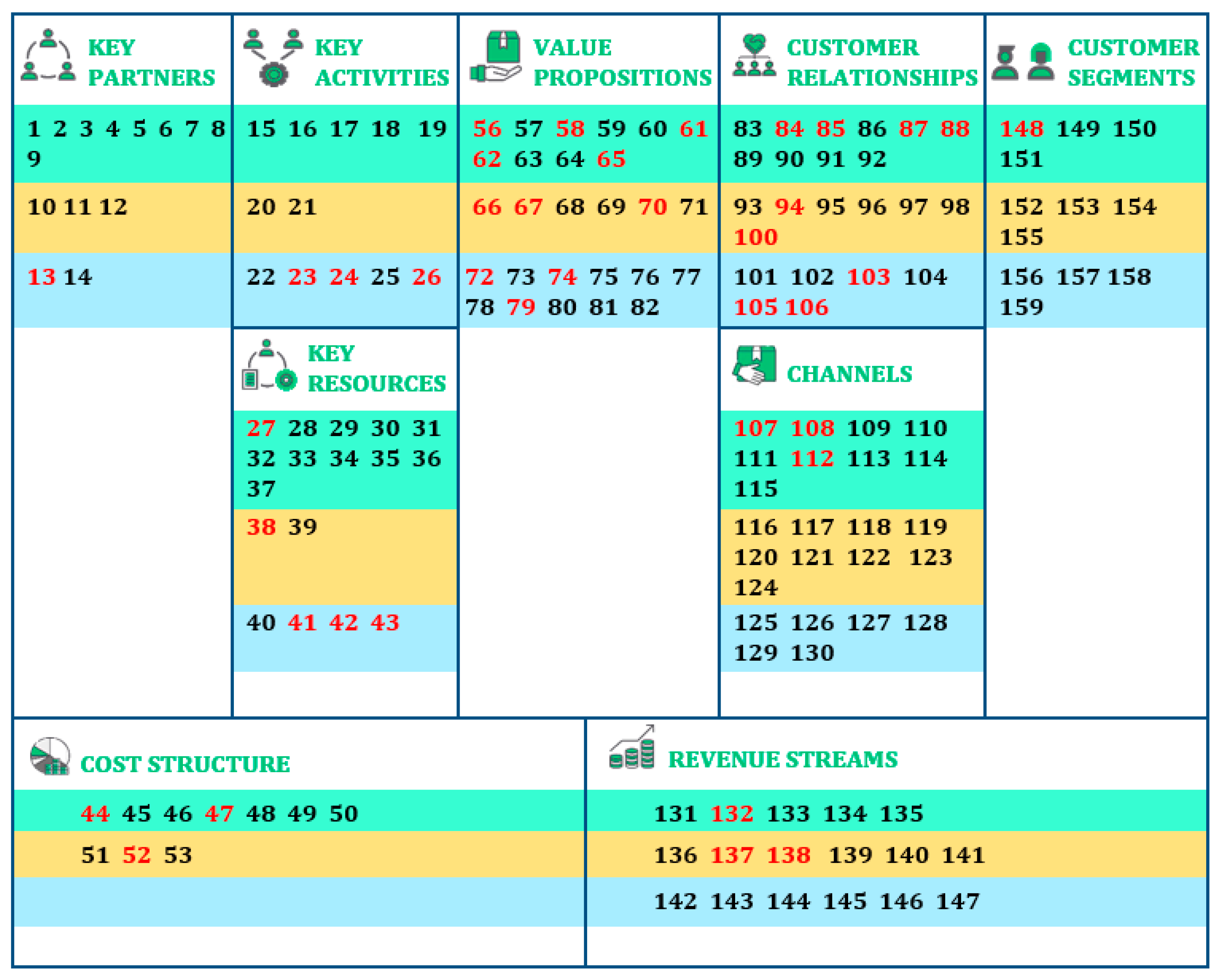
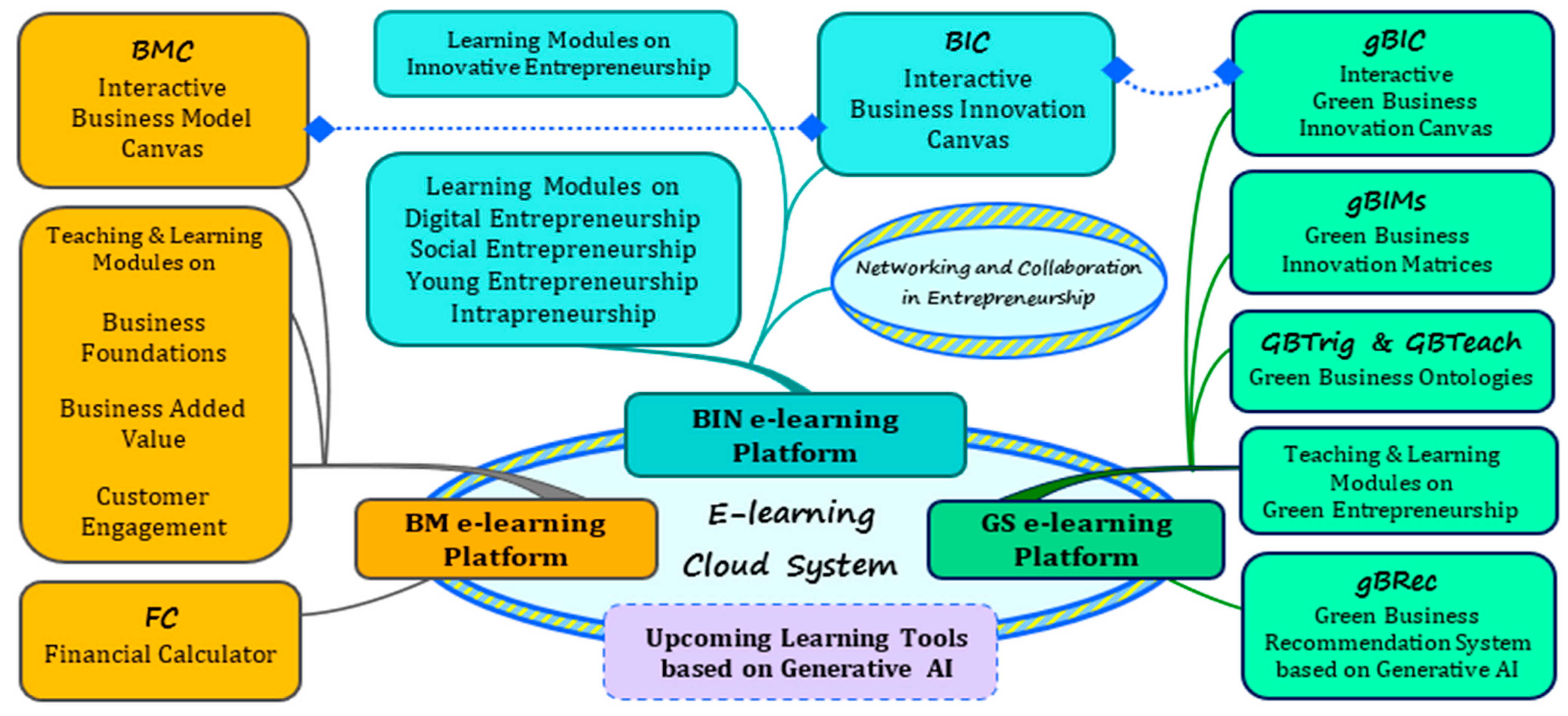
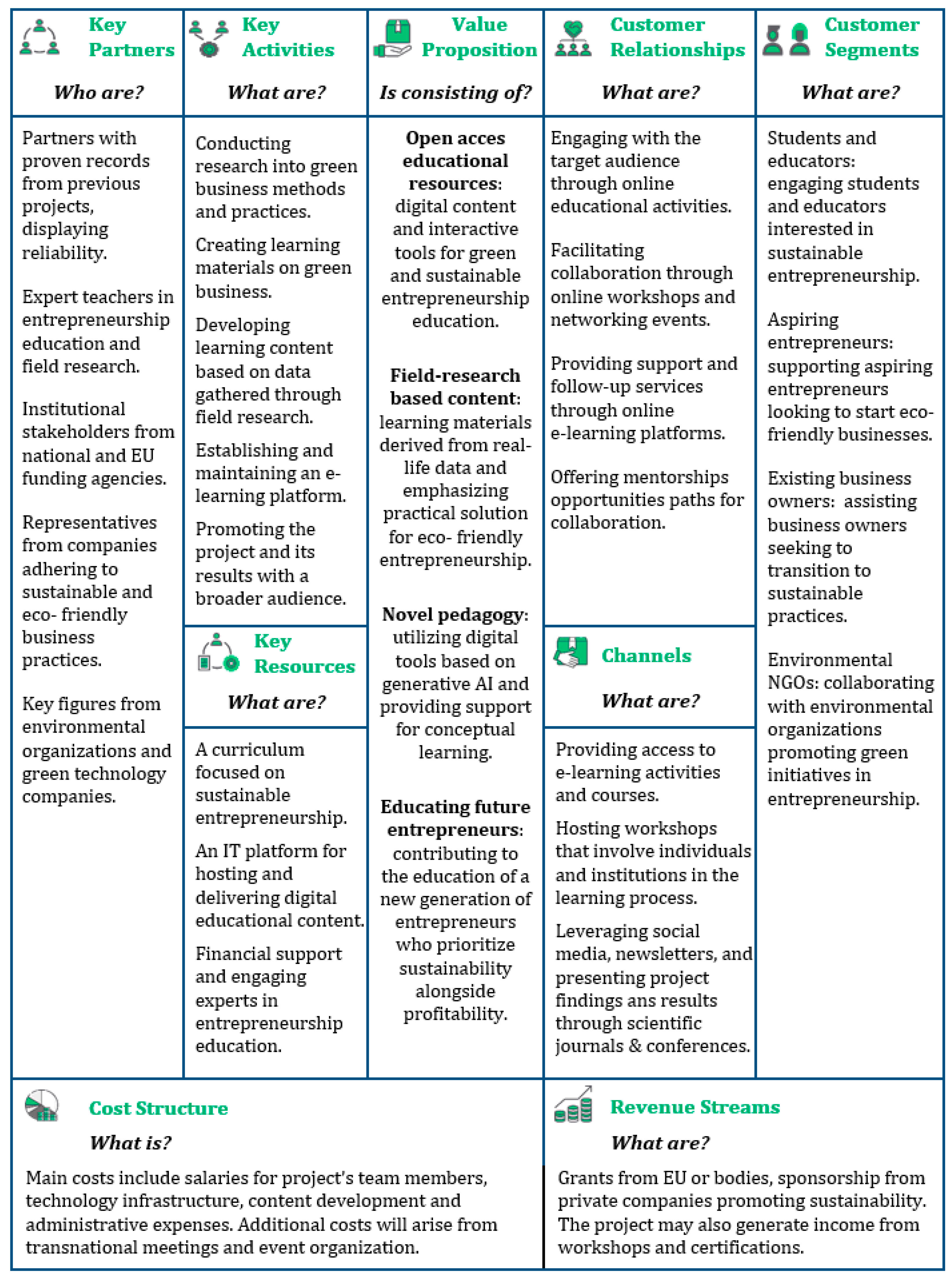
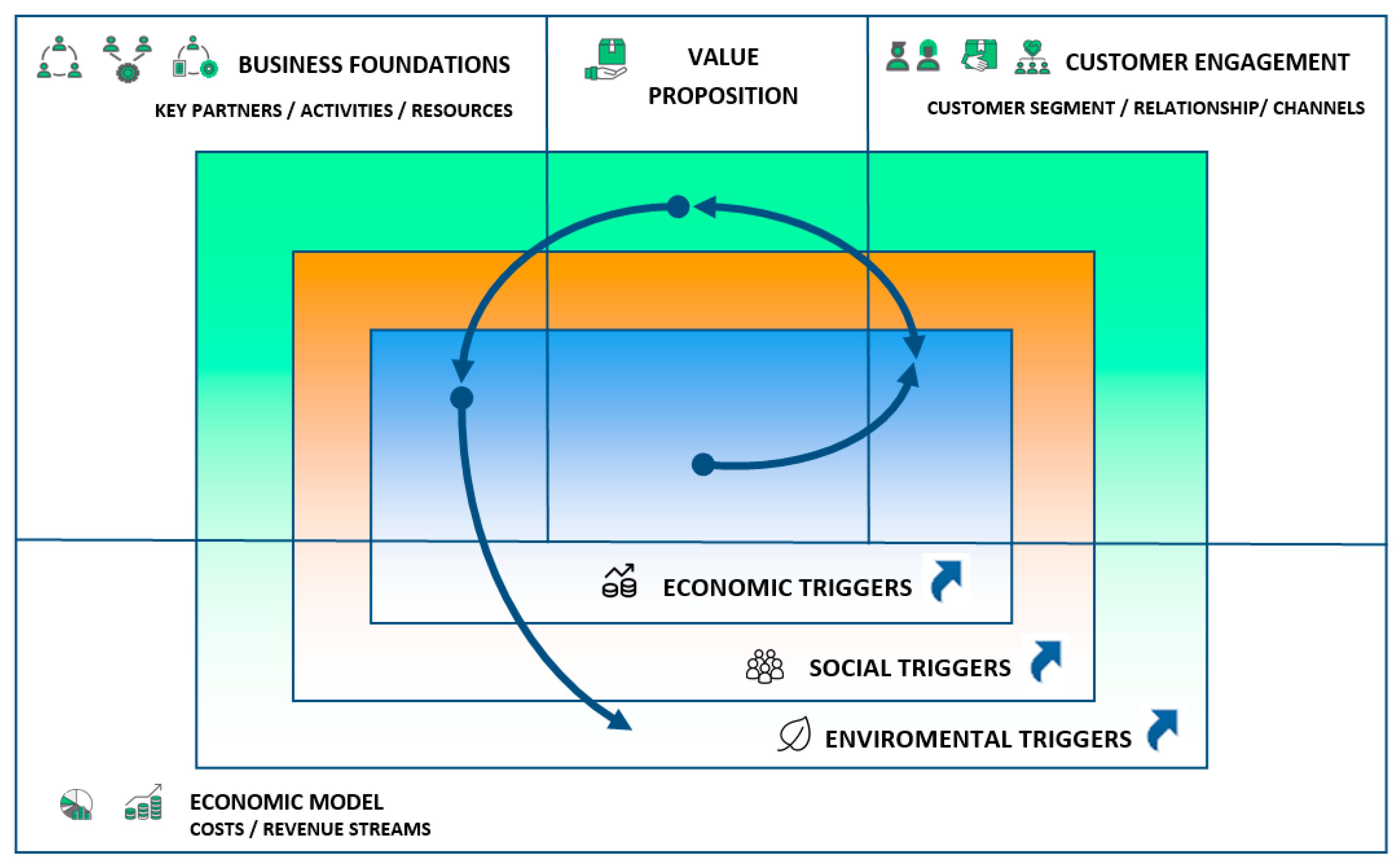
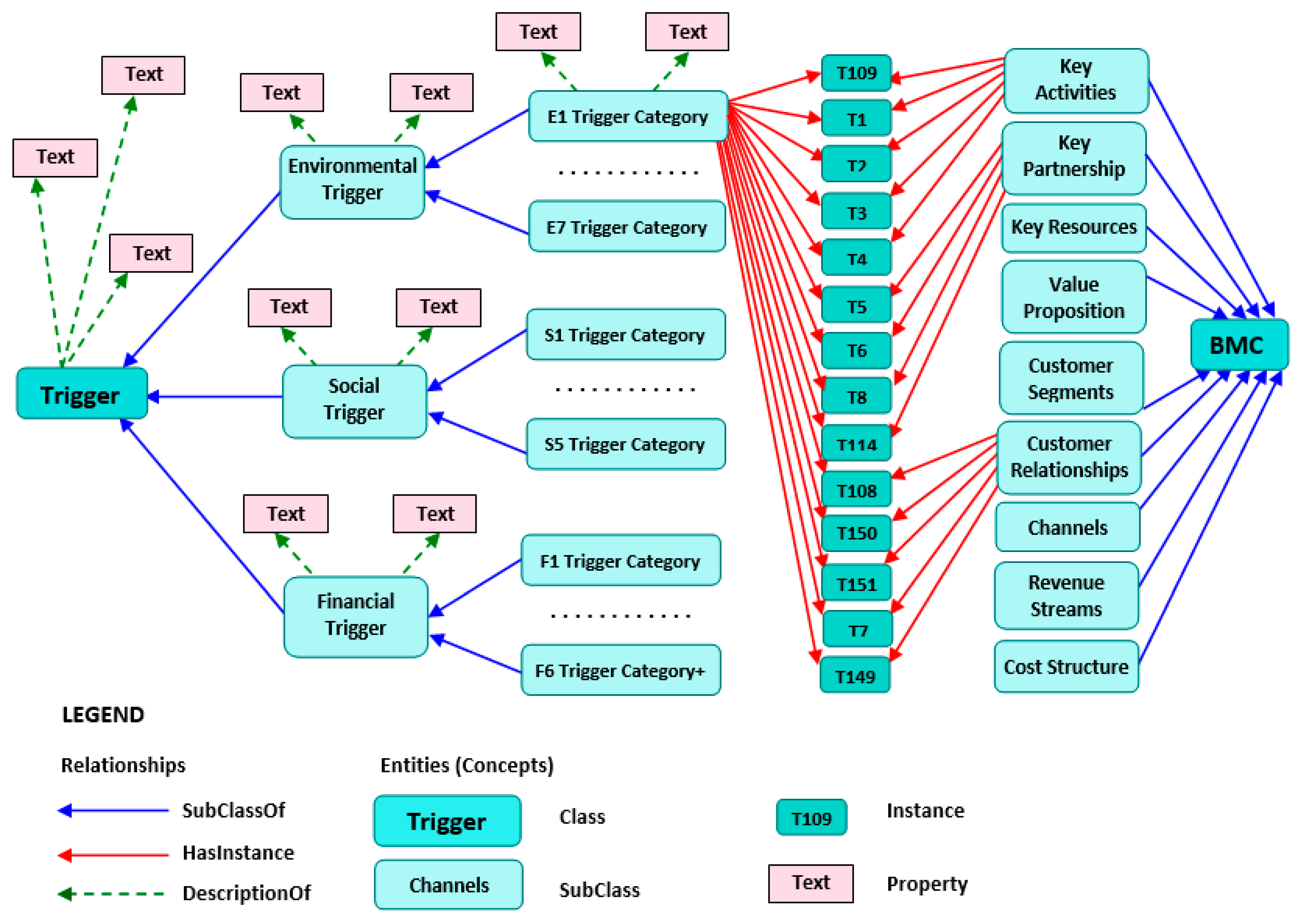
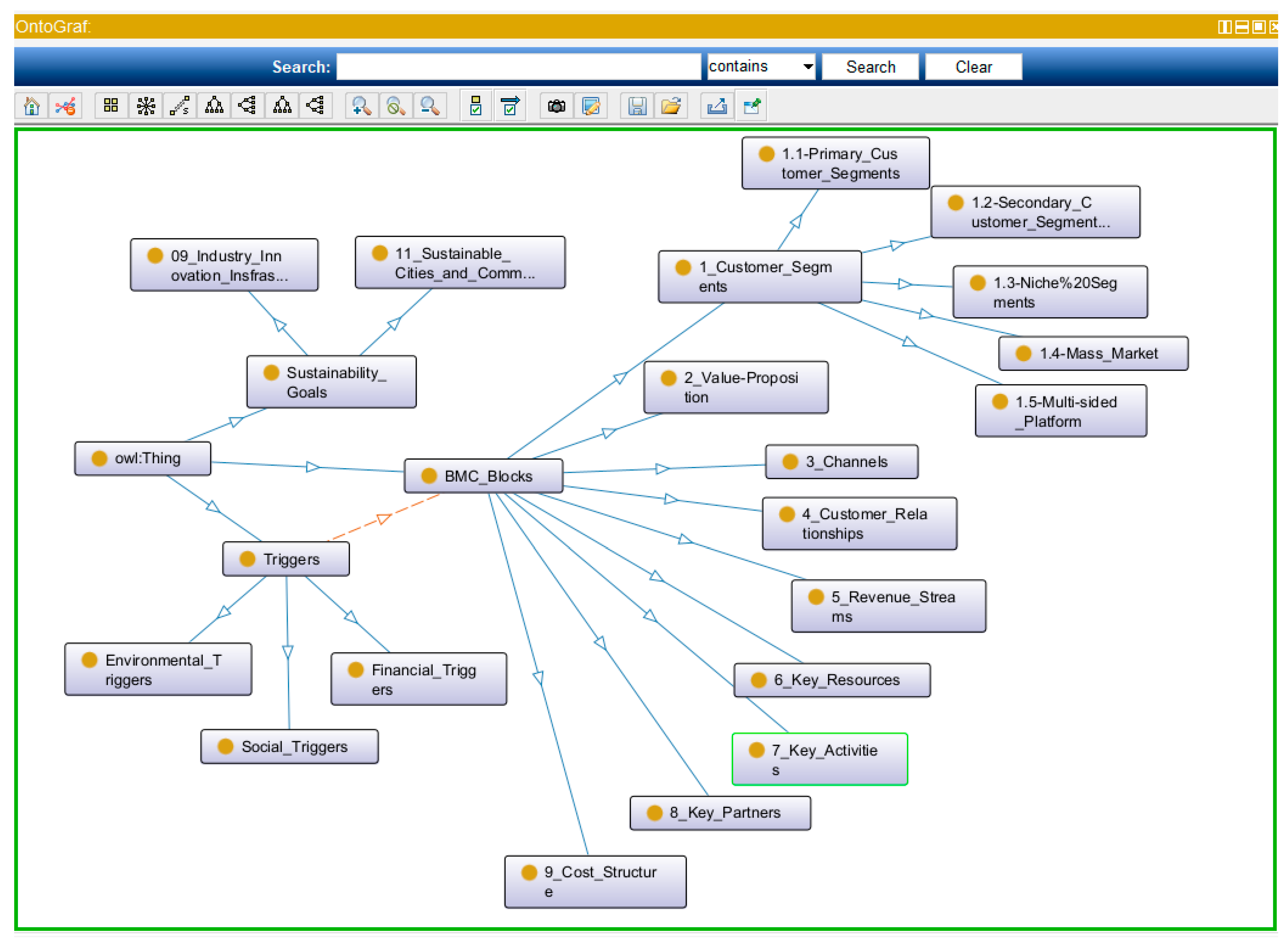
| Category | Subcategory | Number of Respondents |
|---|---|---|
| Gender | Male | 42 |
| Female | 22 | |
| Prefer not to indicate | 0 | |
| Age | Below 25 years | 2 |
| 25–39 years | 28 | |
| 40–59 years | 31 | |
| 60 years and above | 3 | |
| Current position in company | President/owner | 35 |
| Managing director | 10 | |
| Department manager | 14 | |
| Team manager | 5 | |
| Size of the company (Staff headcount) | 1–9 | 22 |
| 10–50 | 26 | |
| 50–250 | 16 | |
| Company’s business field | R&D | 4 |
| Production | 34 | |
| Services | 16 |
| Business Model Canvas Block | Environmental Triggers |
|---|---|
| Customer segments (responsible customers) | 148. Eco-friendly customer engagement practices 149. Partner eco-conscious firms 150. Partner eco-conscious NGOs 151. Sustainable institutions |
| Value proposition | 56. Sustainable products and services 57. Reduce environmental impact 58. Local material sourcing 59. Lower transportation costs 60. Use sustainable materials 61. Sustainable food production 62. Minimize packaging waste 63. Closed-loop waste reduction 64. Green products 65. Renewable energy |
| Business Model Canvas Block | Environmental Triggers |
|---|---|
| Channels (responsible customers) | 107. Online self-service 108. Local material suppliers 109. Sustainable supply chains 110. Waste management logistics 111. Eco-friendly transportation 112. E-commerce websites 113. Digital communication channels 114. Focus on local suppliers 115. Local distribution channels |
| Customer relationships | 83. Sustainable products and services 84. Reduce environmental impact 85. Loal material sourcing 86. Lower transportation costs 87. Use sustainable materials 88. Sustainable food production 89. Minimize packaging waste 90. Zero waste delivery 91. Sustainable logistic processing 92. Eco-friendly delivery |
| Primary Trigger Groups | Subgroups in Primary Trigger Groups | Triggers in Subgroup |
|---|---|---|
| Environmental triggers | Sustainable Partnerships and Collaboration | 1, 2, 3, 4, 5, 6, 7, 8, 149, 150, 151, 114, 108 |
| Resource Efficiency and Waste Management | 28, 29, 35, 36, 46, 63, 62, 88, 90,135, 91, 110 | |
| Renewable Energy and Emission Reduction | 30, 31, 47, 50, 32, 57, 65, 49, 134 | |
| Eco-Friendly Products and Services | 56, 64, 132, 61, 133, 148 | |
| Innovation and Technology for Sustainability | 27, 9, 34, 84, 107, 113, 112 | |
| Water and Resource Conservation | 37, 48, 44, 58, 45, 59 | |
| Sustainable Logistics and Transportation | 83, 92, 91, 111, 115 | |
| Education, Corporate Social Responsibility, and Community Engagement | 19, 131, 87, 148 | |
| Social triggers | Community Engagement and Development | 66, 138, 117, 118, 119, 96, 97, 98, 139, 155 |
| Education and Awareness | 152, 116, 93, 121, 68, 120, 141, 140 | |
| Sustainable Operations and Processes | 100, 52, 136, 137, 38, 153, 70, 51 | |
| Ethical and Social Responsibility | 124, 154, 69, 21, 71, 122, 123, 12 | |
| Environmental Programs and Standards | 67, 94, 20, 95, 99, 10, 53, 39 | |
| Financial triggers | Financial Sustainability and Green Finance | 13, 14, 23, 24, 26, 42, 43, 55, 146, 147, 159 |
| Technology and Innovation | 54, 72, 74, 75, 79, 82, 101, 105, 106, 142, 143 | |
| Customer and Market Engagement | 125, 126, 130, 156, 157, 158 | |
| Operations and Logistics | 102, 103, 128, 129, 145 | |
| E-Commerce and Digitalization | 76, 81, 104, 127, 144 | |
| Resource Management and Green Practices | 22, 25, 40, 41, 73, 77, 78, 80 |
| BMC Block | BMC Block-Section | Financial Triggers Within the Block-Sections |
|---|---|---|
| Customer segments | Primary customer segment | 157. Customer market expansion |
| Niche segments | 156. Service/products packages | |
| Value proposition | Product/service features | 72. Innovative technologies 79. Eco-friendly practices 82. Sustainable technology solutions 102. Eco-friendly delivery vehicles |
| Problem solved | 77. Assess operations sustainability 78. Customize/assess sustainability | |
| Customer gains | 146. Green practices funds 147. Sustainable revenue generation | |
| Unique selling proposition | 158. Transparency |
Disclaimer/Publisher’s Note: The statements, opinions and data contained in all publications are solely those of the individual author(s) and contributor(s) and not of MDPI and/or the editor(s). MDPI and/or the editor(s) disclaim responsibility for any injury to people or property resulting from any ideas, methods, instructions or products referred to in the content. |
© 2025 by the authors. Licensee MDPI, Basel, Switzerland. This article is an open access article distributed under the terms and conditions of the Creative Commons Attribution (CC BY) license (https://creativecommons.org/licenses/by/4.0/).
Share and Cite
Cocu, A.; Pecheanu, E.; Susnea, I.; Dingli, S.; Istrate, A.; Tudorie, C. Technology-Enabled Learning for Green and Sustainable Entrepreneurship Education. Adm. Sci. 2025, 15, 45. https://doi.org/10.3390/admsci15020045
Cocu A, Pecheanu E, Susnea I, Dingli S, Istrate A, Tudorie C. Technology-Enabled Learning for Green and Sustainable Entrepreneurship Education. Administrative Sciences. 2025; 15(2):45. https://doi.org/10.3390/admsci15020045
Chicago/Turabian StyleCocu, Adina, Emilia Pecheanu, Ioan Susnea, Sandra Dingli, Adrian Istrate, and Cornelia Tudorie. 2025. "Technology-Enabled Learning for Green and Sustainable Entrepreneurship Education" Administrative Sciences 15, no. 2: 45. https://doi.org/10.3390/admsci15020045
APA StyleCocu, A., Pecheanu, E., Susnea, I., Dingli, S., Istrate, A., & Tudorie, C. (2025). Technology-Enabled Learning for Green and Sustainable Entrepreneurship Education. Administrative Sciences, 15(2), 45. https://doi.org/10.3390/admsci15020045





